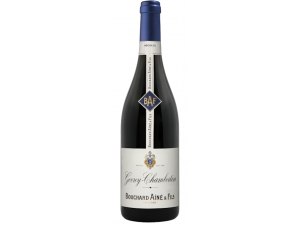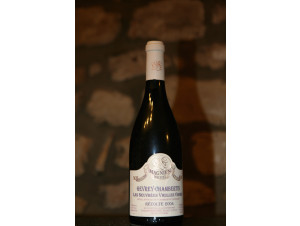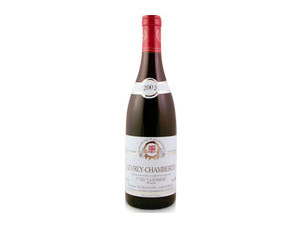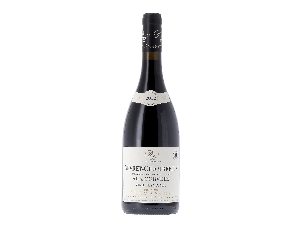You have no items in your shopping cart.
Wine Gevrey-Chambertin
Gevrey-Chambertin is one of Burgundy's world-renowned flagship appellations. It is the largest vineyard of the Côte de Nuits. Often described as the gateway to the "Champs Elysées" of Burgundy. The Gevrey-Chambertin appellation produces red wines exclusively from the Pinot Noir grape. Read more on Gevrey-Chambertin
-
Top Selling
-
Top Selling
-
Top Selling
- -17%
- -27%
- -27%
- -24%
Appellation Gevrey-Chambertin
Gevrey-Chambertin is a village appellation, a 1er Cru and a Grand Cru with 9 classified climats. When you open a bottle of Gevrey-Chambertin, you are presented with a history that goes back more than a thousand years, a unique geological heritage and an ancestral know-how that has been passed down from generation to generation.
The wines of Gevrey-Chambertin date back to the Gallo-Roman era
The history of Gevrey-Chambertin is intimately linked to the culture of the vine. Its name alone is a tribute to this culture. Indeed, Gevrey was the first Burgundian commune to have obtained in 1847 the right to add to its name that of the most prestigious climate of its terroir namely "Chambertin", to become Gevrey-Chambertin.
The cultivation of vines has been attested to on the terroir of Gevrey-Chambertin since the 1st century BC. Recent archaeological excavations have revealed the presence of rows of vines dating from the Gallo-Roman period. Like the whole of the Burgundian vineyard, it is from the Middle Ages onwards, under the impetus of the monastic orders and in particular under the influence of the Abbey of Cluny (910), that the cultivation of the vine and the commercialisation of wine will take on a real importance. The mark of this ecclesiastical development remains today through the most emblematic climes of the appellation and first and foremost the Clos de Bèze, planted by the Monks of the Abbaye de Bèze in 630.
The wines of Gevrey Chambertin would experience an imperial spotlight in the 19th century. Indeed Napoleon made it his favourite wine and at the same time an advertisement that would cross time and borders. The story goes that Napoleon lost the battle of Waterloo because he did not have time to drink his glass of Chambertin.
The end of the 19th century was marked by two great plagues of the vine which were mildew and phylloxera. The reconstruction of the vineyard by the winegrowing communities will rely heavily on the particularity of the Viticultural Climates, their highlighting and defence. These reconstruction efforts will lead to the creation of the Appellations d'Origine Contrôlée. The Gevrey-Chambertin appellation would be instituted by decree on 11 September 1936. This appellation includes 26 climats classified as Premier Cru and 9 Grands Crus.
The 26 climats classified as Premier Cru are: la Bossière, la Romanée, Poissenot, Estournelles Saint Jacques, Clos des Varoilles, Champonnet, Lavaut Saint Jacques, Craipillot, Les Cazetiers, Les Corbeaux, Clos du Chapitre, Issarts, Clos Saint Jacques, Au Closeau, Champeaux, La Perrière, Petits Cazetiers, Clos Prieur, Combe au Moine, En Ergot, Les Goulots, Petite Chapelle, Aux Combottes, Cherbaudes, Bel Air, Fonteny. The 9 Climats classified as Grand Cru are : Ruchottes, Mazis, Clos de Bèze, Mazoyères, Latricières, Chapelle, Charmes, Griotte and Chambertin.
What are the characteristics of the Gevrey-Chambertin vineyard?
Located on the Côtes de Nuits, halfway between Dijon and Nuits-Saint-Georges, the Gevrey-Chambertin appellation includes the communes of Gevrey-Chambertin and Brochon. The vineyard covers an area of 411 hectares located at an altitude between 280 and 380 metres. The vineyard is located on the northern and southern slopes of the famous Combe Lavaux as well as on its alluvial cone.
South of the Combe are the 9 Grands Crus. This terroir benefits from the best drainage conditions and perfect sun exposure. The soils consist of Bathonian substrates as well as marl and fossil-rich Bajocian limestone.
North of the Combe Lavaux, on the Côte Saint-jacques, are the climats of the Premiers Crus. The vines are located in an area at an altitude of 350 metres and benefit from a brown limestone, marl-clay soil. Finally, in the heart of the vineyard, the vines of the village appellation located on the alluvial cone benefit from a soil composed of marl, red silt and scree. The Gevrey-Chambertin appellation enjoys a cool oceanic climate, alternately disturbed by continental and southern influences.
Gevrey-Chambertin wines are made to keep
.The Gevrey-Chambertin appellation produces exclusively red wines made from the Pinot Noir grape. The extent of the vineyard as well as the diversity of the terroirs offer a wide range of wines.
The wines of Gevrey-Chambertin reveal a ruby red robe of a beautiful vivacity in their youth. With age, this colour becomes tinged with carmine reflections and gains in depth. On the nose, the primary aromas of Gevrey-Chambertin offer a bouquet of fresh red and black fruits, on strawberry and blackberry, floral notes, on rose, violet and reseda. The secondary aromas reveal another aromatic range with spicy notes on liquorice, leather and undergrowth. On the palate, the wines are distinguished by their power, with a firm structure and rich, silky tannins. Gevrey-Chambertin wines have that special balance that gives them a full-bodied, velvety-coated material.
The wines of Gevrey-Chambertin are wines for laying down and for great aging. The wines in the village appellation are pleasant from their youth but can be enjoyed for up to 10 years. The wines in 1er Cru and Grand Cru a potential ageing of 30 years.
Gevrey-Chambertin wines are powerful and velvety
With its full, powerful and velvety profile, Gevrey-Chambertin wine is a great ally to accompany an entire meal. Naturally, it is a wine that will sublimate the gastronomic specialities of its region, and Burgundy does not lack resources in this respect. As a non-exhaustive list, we could mention among these dishes the nice pairing with oeuf meurettes, Boeuf bourguignon, the fondue bourguignonne, the tourte à l'époisse or the Coq au Chambertin.
More generically, Gevrey-Chambertin is a very appropriate wine to accompany game or any other musky and marinated meats. It is also possible to associate it with fish such as a fillet of pike-perch or a tuna in red wine sauce. This wine will prove to be an excellent companion for cheeses, especially cheeses with character. Finally, it will enhance chocolate or red fruit desserts or a pear with wine.
Discovering 2 remarkable domains in Gevrey-Chambertin
.The Domaine Trapet:
This family-run wine estate was founded in 1919 in Gevrey-Chambertin, today it is the 5th generation that perpetuates a traditional know-how. The vineyard of the estate covers an area of 15 hectares including notably three Grands Crus and two 1er Cru. The vines have been managed in biodynamic agriculture since 1995. The wines made at Domaine Trapet have gained a definite reputation and are now a reference in the wine world.The Domaine Armand Rousseau:
This family business was founded in the early 20th century by Armand Rousseau. Today, it is the 4th generation that manages the 15 hectares of vines, taking care to enhance the family values that can be translated into 4 words: Pleasure, Requirement, Love and Sharing.
Bourgogne appellations































 TWIL - Achat de Vin
TWIL - Achat de Vin


